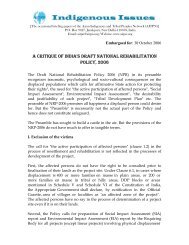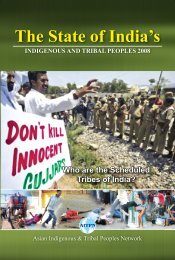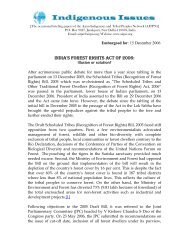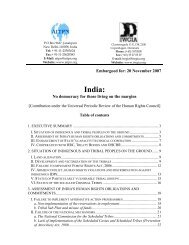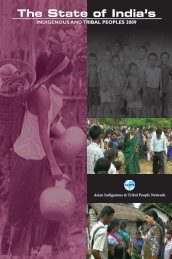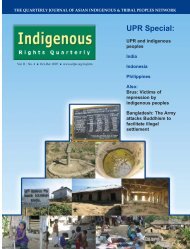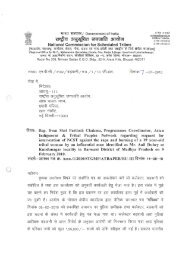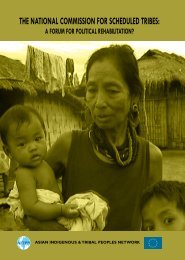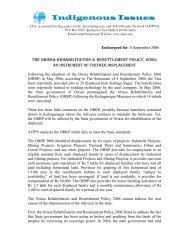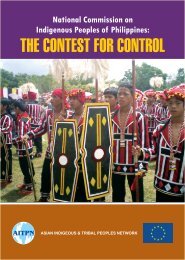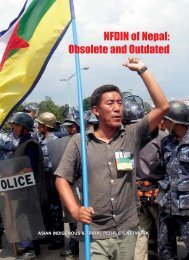Victims of Barbed-Wires - Asian Indigenous and Tribal Peoples ...
Victims of Barbed-Wires - Asian Indigenous and Tribal Peoples ...
Victims of Barbed-Wires - Asian Indigenous and Tribal Peoples ...
Create successful ePaper yourself
Turn your PDF publications into a flip-book with our unique Google optimized e-Paper software.
[The occasional briefing papers <strong>of</strong> the <strong>Asian</strong> <strong>Indigenous</strong> <strong>and</strong> <strong>Tribal</strong> <strong>Peoples</strong> Network (AITPN)]<br />
P.O. Box 9627, Janakpuri, New Delhi-110058, India<br />
Email: aitpn@aitpn.org; Website: www.aitpn.org<br />
Embargoed for: 27 April 2006<br />
VICTIMS OF BARBED-WIRES:<br />
Chakmas' existence in Mizoram threatened by<br />
Indo-Bangladesh Border Fencing<br />
The tribals in India have been the disproportionate victims <strong>of</strong> the projects<br />
undertaken by the State or the private companies in the name <strong>of</strong> development<br />
or national interest. Millions <strong>of</strong> them have been displaced across India <strong>and</strong><br />
then left to lurch. Thous<strong>and</strong>s <strong>of</strong> impoverished indigenous peoples, mainly the<br />
Chakmas living along the international border in Western <strong>and</strong> South-Western<br />
side <strong>of</strong> Mizroam state are the new additions.<br />
The government <strong>of</strong> India has been erecting fencing along its 4096.7 km-long<br />
border with Bangladesh running through five Indian states <strong>of</strong> West Bengal,<br />
Assam, Meghalaya, Tripura <strong>and</strong> Mizoram in order to stop infiltration,<br />
smuggling <strong>and</strong> other alleged anti-India activities from across the border. As<br />
in March 2006, 2,187 km have been fenced. The border fencing project has<br />
received top priority <strong>and</strong> its completion has been advanced from 2007 to 2006.<br />
The fencing has created numerous problems especially relating to survival <strong>of</strong><br />
the displaced persons. In March 2006, the state government <strong>of</strong> Meghalaya<br />
temporarily suspended the border fencing works following protests by the<br />
indigenous peoples in Khasi <strong>and</strong> Jaintia Hills as their villages have fallen on<br />
the other side <strong>of</strong> the border due to demarcation <strong>of</strong> the boundary.<br />
Yet, fencing <strong>of</strong> 318 km-long stretch in Mizoram sector is going on in full<br />
swing despite calls from the Indo-Bangladesh Border Fencing Affected<br />
Families Resettlement Dem<strong>and</strong> Committee (IBBFARDCOM) <strong>of</strong> Mizoram to<br />
immediately halt construction <strong>of</strong> the border fencing until all the affected<br />
families are "fully <strong>and</strong> properly" rehabilitated. Such calls have fallen on deaf<br />
ears <strong>of</strong> the authorities in New Delhi.<br />
I. Extent <strong>of</strong> displacement<br />
A house to house survey conducted by IBBFARDCOM <strong>of</strong> Mizoram found<br />
that the fencing will displace a total <strong>of</strong> 5,790 Chakma tribal families consisting
VICTIMS OF BARBED-WIRES:<br />
Chakmas' existence in Mizoram threatened by Indo-Bangladesh Border Fencing<br />
2<br />
<strong>of</strong> 35,438 persons from 49 villages. These villages are located on the banks <strong>of</strong><br />
four rivers, viz. Thega, Karnaphuli, Harina <strong>and</strong> Sajek, which form the natural<br />
boundary between India <strong>and</strong> Bangladesh.<br />
Most <strong>of</strong> the 49 villages affected by the border-fencing project will have to be<br />
entirely relocated due to their proximity to the international border. Apart<br />
from loss <strong>of</strong> their immovable houses <strong>and</strong> properties, the villagers will lose<br />
already developed wet rice cultivation l<strong>and</strong>s, horticulture gardens, gardens<br />
for growing vegetables <strong>and</strong> other cash crops, tree plantations <strong>of</strong> high<br />
commercial values like teak etc, community/ government assets like schools,<br />
health sub-centres, community halls, market places, places <strong>of</strong> worship, play<br />
grounds, cemetery/ grave yards, water ponds, water supply, <strong>and</strong> other<br />
government/ council <strong>of</strong>fice buildings, etc.<br />
II. Life without access to rivers<br />
The Chakma inhabited areas along the Indo-Bangladesh border are extremely<br />
backward <strong>and</strong> most <strong>of</strong> the villages are inaccessible due to the absence <strong>of</strong><br />
roads. The rivers have been the lifelines for survival <strong>of</strong> the Chakmas. Apart<br />
from drawing water for drinking, washing <strong>and</strong> other purposes, the Chakma<br />
villagers also use the rivers to conduct business <strong>and</strong> commerce, as there are<br />
no other means <strong>of</strong> transportation. They also perform the last rites <strong>of</strong> the<br />
deceased on the river banks. The river banks are fertile <strong>and</strong> used for<br />
cultivations <strong>of</strong> the paddy, vegetables <strong>and</strong> others cash crops. As the fencing<br />
will be erected up to 150 yards inside India, these rivers will fall outside the<br />
territory <strong>of</strong> India, <strong>and</strong> hence will be no longer accessible to the inhabitants.<br />
This will further break the backbone <strong>of</strong> the Chakmas who are already weak<br />
economically. They cannot think <strong>of</strong> their lives without the rivers; but now<br />
they will have to learn hard to try to live without access to the rivers.<br />
III. Blatant violations <strong>of</strong> the laws<br />
The Ministry <strong>of</strong> Home Affairs <strong>of</strong> the government <strong>of</strong> India issued guidelines<br />
for acquisition <strong>of</strong> the l<strong>and</strong>s prior to construction <strong>of</strong> the fencing. In its various<br />
communications to the four implementing agencies, the Ministry <strong>of</strong> Home<br />
Affairs clearly stated that the four construction companies "shall be<br />
responsible for liaisoning with the State Government/ local authorities for<br />
acquisition <strong>of</strong> l<strong>and</strong> <strong>and</strong> getting forest/ environment clearance for carrying out<br />
the fencing & related works”, <strong>and</strong> that they "shall finalize the alignment <strong>of</strong> the<br />
<strong>Indigenous</strong> Issues – The Occasional Briefing Papers <strong>of</strong> AITPN
VICTIMS OF BARBED-WIRES:<br />
Chakmas' existence in Mizoram threatened by Indo-Bangladesh Border Fencing<br />
3<br />
fencing in consultation with BSF (Border Security Forces) & DM (District<br />
Magistrate) <strong>of</strong> the area where the fencing is proposed".<br />
However, the four construction companies which were accorded the contracts<br />
in Mizoram sector, namely Engineering Projects India Limited, National<br />
Projects Construction Corporation Ltd., Border Roads Organization <strong>and</strong><br />
National Building Construction Corporation Ltd had started acquiring l<strong>and</strong>s<br />
<strong>and</strong> erecting the fencing in their respective portions without any consultation<br />
with the tribal inhabitants or the local authorities, including the DM <strong>and</strong> the<br />
BSF.<br />
Despite complaints by the IBBFARDCOM, the Government <strong>of</strong> India has<br />
maintained an astounding silence <strong>and</strong> has not taken any corrective measures.<br />
Following submission <strong>of</strong> representation by the IBBFARDCOM to the Chief<br />
Minister <strong>of</strong> Mizoram, the state government constituted a "State Level Coordination<br />
Committee on Border Fencing" on 21 April 2006 to ensure that the<br />
victims received proper compensation <strong>and</strong> rehabilitation. But the Coordination<br />
Committee did not include any Chakma representative. This<br />
reflects the extent <strong>of</strong> apathy on the part <strong>of</strong> the authorities towards the plight<br />
<strong>of</strong> the border-fencing victims.<br />
The implementation <strong>of</strong> the Indo-Bangladesh border fencing project is all set to<br />
break the backbone <strong>of</strong> the already impoverished Chakma tribals. As we go<br />
the print, government <strong>of</strong> India has failed to take any corrective measures<br />
while the fencing continues gather pace.<br />
<strong>Indigenous</strong> Issues – The Occasional Briefing Papers <strong>of</strong> AITPN



